story and photos by Kayte Deioma
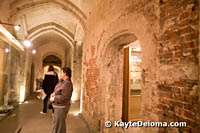 The saying “One man’s trash is another man’s treasure,” could be the motto of the field of archaeology, where a broken pottery shard, a flint or a chicken bone can elicit more excitement than discovering gold. The archaeologists hit the jackpot in Brussels when new construction in 1995 revealed that the lower levels of the Royal Palace on Coudenberg Hill which burned down in 1731, were left largely intact when they flattened the area in 1774 to build a new royal compound. After a six-year excavation, the restored underground passages were opened to the public in 2001.
The saying “One man’s trash is another man’s treasure,” could be the motto of the field of archaeology, where a broken pottery shard, a flint or a chicken bone can elicit more excitement than discovering gold. The archaeologists hit the jackpot in Brussels when new construction in 1995 revealed that the lower levels of the Royal Palace on Coudenberg Hill which burned down in 1731, were left largely intact when they flattened the area in 1774 to build a new royal compound. After a six-year excavation, the restored underground passages were opened to the public in 2001.
You won’t find any of the royal chambers here, but the maze of cellars, kitchens, cesspools,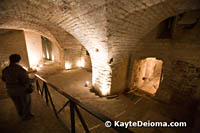 and a street that ran along the outside of the palace give a glimpse of the support system for the Archdukes, and Duchesses, Princes and Emperors who resided here.
and a street that ran along the outside of the palace give a glimpse of the support system for the Archdukes, and Duchesses, Princes and Emperors who resided here.
The oldest parts of the underground ruins are remnants of the original castle walls from the 12th century. Arches were added to support an expansion of the castle and city fortifications in the 14th century.
The devout Catholicism of the Hapsburgs can be seen in the chapel added to the compound by Emperor Charles V in the first half of the 16th century. Its basic shape remains in the form of a sub-basement, one of two levels built down the hillside so the chapel above would be at palace level.
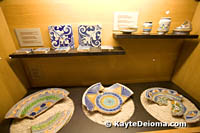 Part of the chapel cellar now houses an exhibit of the artifacts discovered in the excavation. 16th century chamber pots, book clasps and random utensils were recovered from the cesspools. Heater tiles and a plethora of architectural remains and everyday items were found in the rubble of the Grand Hall. One display case contains a colorful collection of broken bits of 16th century majolica architectural tiles, dinner plates and apothecary vessels.
Part of the chapel cellar now houses an exhibit of the artifacts discovered in the excavation. 16th century chamber pots, book clasps and random utensils were recovered from the cesspools. Heater tiles and a plethora of architectural remains and everyday items were found in the rubble of the Grand Hall. One display case contains a colorful collection of broken bits of 16th century majolica architectural tiles, dinner plates and apothecary vessels.
Interpretive panels also break down the royal family tree, putting into context how the 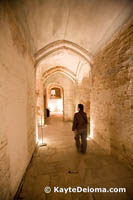 palace’s most famous resident, Charles V, the simultaneous King of Spain, Emperor of Germany and Sovereign of the Low Countries, came to be first emancipated and later abdicated his throne in Brussels.
palace’s most famous resident, Charles V, the simultaneous King of Spain, Emperor of Germany and Sovereign of the Low Countries, came to be first emancipated and later abdicated his throne in Brussels.
The Coudenberg site spreads under what is now the Place Royal, Rue Royal, the Musical Instrument Museum, the Fine Art Museum, the Royal Palace, and the Bellevue Museum, which is where you’ll find the entrance to the underground passages. A very thorough printed English language guide is available at the ticket desk. English-speaking tour guides can be hired by appointment.
Former Palace of Brussels:
Coudenberg Archaeological Site
Mont des Arts/Kunstberg
Place des Palais, 7
1000 Brussels, Belgium
Phone: 32 (0)2.545.08.00
Email: info@coudenberg.com
www.coudenberg.com

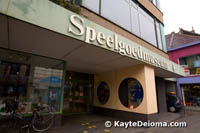
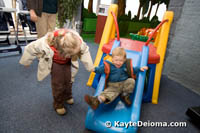
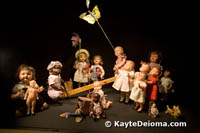
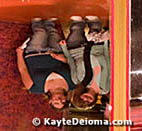
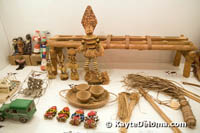
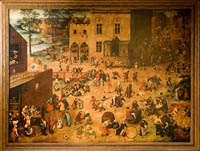
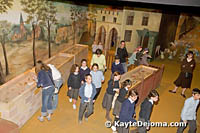
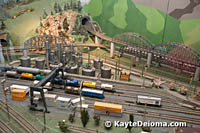
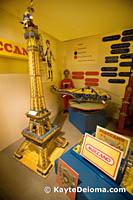
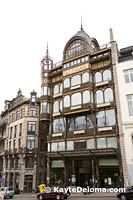 A true gem on the Mont des Arts in Brussels is the Musical Instrument Museum (MIM), home to one of the largest collections of musical apparatuses in the world. Founded in 1877 as part of the Royal Museums of Art and History, the museum moved into the former Old England department store, an 1899 masterpiece of Art Nouveau architecture, in 2000. Twelve hundred of the 7,000 instruments in the collection are on display at any given time.
A true gem on the Mont des Arts in Brussels is the Musical Instrument Museum (MIM), home to one of the largest collections of musical apparatuses in the world. Founded in 1877 as part of the Royal Museums of Art and History, the museum moved into the former Old England department store, an 1899 masterpiece of Art Nouveau architecture, in 2000. Twelve hundred of the 7,000 instruments in the collection are on display at any given time.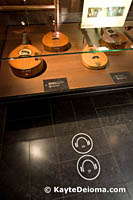 there was a printed English language guide to help you navigate the museum, but they were all out of them. You can still enjoy the museum without understanding the descriptions since included in the price of admission is an infrared audio tour that plays the music of over 200 of the instruments when you stand near the designated headphone icon.
there was a printed English language guide to help you navigate the museum, but they were all out of them. You can still enjoy the museum without understanding the descriptions since included in the price of admission is an infrared audio tour that plays the music of over 200 of the instruments when you stand near the designated headphone icon.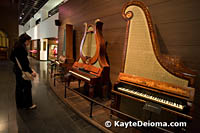 Listening to the rare and exotic instruments while admiring their artistry and craftsmanship becomes a more sensory experience when there’s no intellectual information to clutter the mind. You can experience the drone of Tibetan trumpets and the sinewy tones of serpent-headed Russian clarinets. In the keyboard section you can hear the difference between the harpsichords, spinets, virginals, clavicytheriums, clavichords and fortepianos.
Listening to the rare and exotic instruments while admiring their artistry and craftsmanship becomes a more sensory experience when there’s no intellectual information to clutter the mind. You can experience the drone of Tibetan trumpets and the sinewy tones of serpent-headed Russian clarinets. In the keyboard section you can hear the difference between the harpsichords, spinets, virginals, clavicytheriums, clavichords and fortepianos.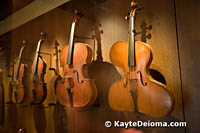 Strings are also well represented with the work of some the best known luthiers, as well as many one-of-a-kind creations. Examples of stringed instruments from five continents can be compared from ancient times to the present.
Strings are also well represented with the work of some the best known luthiers, as well as many one-of-a-kind creations. Examples of stringed instruments from five continents can be compared from ancient times to the present.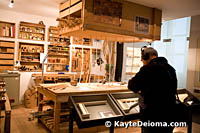 Restoration workshops for keyboards and stringed instruments are integrated into the exhibit galleries and show the tools and processes of instrument construction and repair.
Restoration workshops for keyboards and stringed instruments are integrated into the exhibit galleries and show the tools and processes of instrument construction and repair.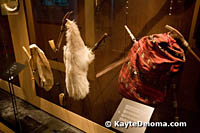 You can see a wide selection of brass horns developed by Belgian musician and inventor Adolph Sax, best known for designing the instrument that was to become known as the saxophone. In another direction, you’ll find the evolution of the bagpipe through different cultures around the world.
You can see a wide selection of brass horns developed by Belgian musician and inventor Adolph Sax, best known for designing the instrument that was to become known as the saxophone. In another direction, you’ll find the evolution of the bagpipe through different cultures around the world.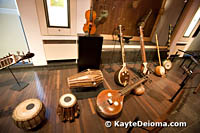 MIM offers a series of concerts in their auditorium. On the first Wednesday afternoon of the month, the museum is free to the public and also presents a selection of live musical presentations in the exhibit galleries. They also offer family concerts on the free Wednesdays.
MIM offers a series of concerts in their auditorium. On the first Wednesday afternoon of the month, the museum is free to the public and also presents a selection of live musical presentations in the exhibit galleries. They also offer family concerts on the free Wednesdays.